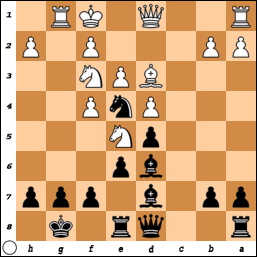When I pointed out that everyone in the tournament was abundantly qualified for an over-15 event, he countered by saying that 15 sounded like 50, and there was no arguing with that.
Paul A O'Neill (2086/201) - Spanton (1900/168)
New London
1.d4 d5 2.Bf4
As I explained in a recent post about a trap in the London System (https://beauchess.blogspot.com/2019/07/london-system-trap.html), one of the points of the New London move-order, ie 2.Bf4 with Nf3 to come rather than 2.Nf3 followed by Bf4, is that it inconveniences Chigorin fanatics who might want to counter 1.d4 d5 2.Nf3 with 2...Nc6, intending to meet 3.Bf4 with 3...Bg4.
2...e6 3.e3 Bd6 4.Bg3 Nf6 5.Nbd2 0-0 6.Bd3 Nc6!?
Komodo9's second-choice, marginally behind 6...b6.
7.Ngf3 Re8?!
The most popular move in ChessBase's 2019 Mega database. It is also Komodo9's second choice (microscopically behind 7...Qe7). The idea is to force a quick ...e5, but White easily prevents that, after which the rook looks misplaced.
8.Ne5 Ne7
I thought 8...Bxe5?! 9.dxe5 Nfd7 was dangerous for Black after 10.f4 or 10.Nf3.
9.c3 Nf5
A normal move would be 9...c5, when White is for choice.
10.Bf4 Nh4?!
Very doubtful. Again ...c5 was normal, but Black always has to reckon with the thrust g4.
11.g3?
The natural 11.Bg5 leaves White strongly placed, as the reply 11...Nxg2? loses a piece to 12.Kf1.
11...Ng2+ 12.Kf1 Nxf4 13.gxf4
White's position with the half-open g file and a knight entrenched on e5 may look strong, but his awkwardly placed king and inability to pose problems on the dark squares mean Black is more-or-less secure from direct attack.
13...c5 14.Rg1 cxd4 15.cxd4 Bd7 16.Ndf3 Ne4
The engines Komodo9 and Stockfish10 do not like this, suggesting instead 16...Re7!?, which may be fine but certainly looks strange.
 |
| Black has just played 16...Ne4. Can you find a strong combination for White? |
*****
*****
*****
*****
No.
The try 17.Nxf7? Kxf7 18.Bxe4 dxe4 19.Ng5+ is well-answered by the engines' 19...Ke7. I would like to think I would have found ...Ke7 at the board, but I was intending the inferior 19...Kg8? 20.Qh5 Bb5+ 21.Kg2 (not 21.Ke1? Qa5+ 22.Kd1 Ba4+ 23.b3 Bxb3+! etc) h6, when the engines show White has a draw by repetition after 22.Nf7 Be2 23.Nxh6+ Kh7 24.Ng4+ Kg8 25.Nh6+ etc. In the postmortem we looked at 22.Qf7+ (instead of 22.Nf7) Kh8 23.Nxe6 Rxe6? 24.Qxe6 Qe7, with approximate equality, missing that Black does not have to surrender the exchange, eg 23...Qf6 gives Black a substantial advantage.
17.Nxd7!?
This surprised me, but it is Komodo9's top pick for quite a while, until it eventually prefers Stockfish10's 17.a4.
17...Qxd7 18.Ne5 Qe7 19.f3 Nf6 20.Kg2 Nh5 21.Od2
PO's other main thought was 21.Qc2, when my suggestion of 21...Rec8! 22.Bxh7+? Kh8 23.Qb1 g6?? fails to 24.Bxg6. But Black wins in this line with 23...Bxe5, when the follow-up ...g6 does indeed trap the white bishop.
21...f5 22.Rac1 Rec8 23.Rc2 Bxe5?!
Solid and good was 23...Rxc2 24.Qxc2 g6, as the white queen has no entry squares into Black's position on the c file.
24.dxe5?!
White is probably slightly better after 24.fxe5 Rxc2 25.Qxc2 Qg5+ 26. Kf2 (I had somehow missed this move) Qh4+ 27.Kf1.
24...Rxc2 25.Qxc2?
White is OK after 25.Bxc2.
25...d4! 26.exd4 Nxf4+ 27.Kh1 Qd7 28.Rc1?
Slightly better is the engines' 28.Qb3, but Black wins a pawn anyway after sidestepping with 28...Kh8.
28...Qxd4 0-1
No comments:
Post a Comment